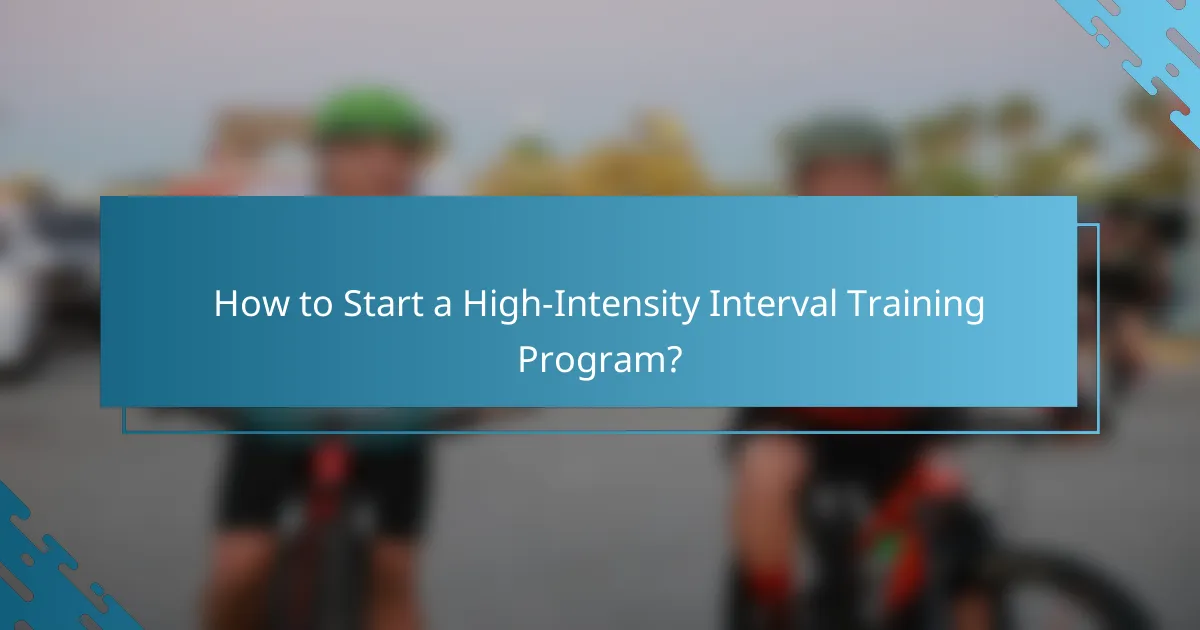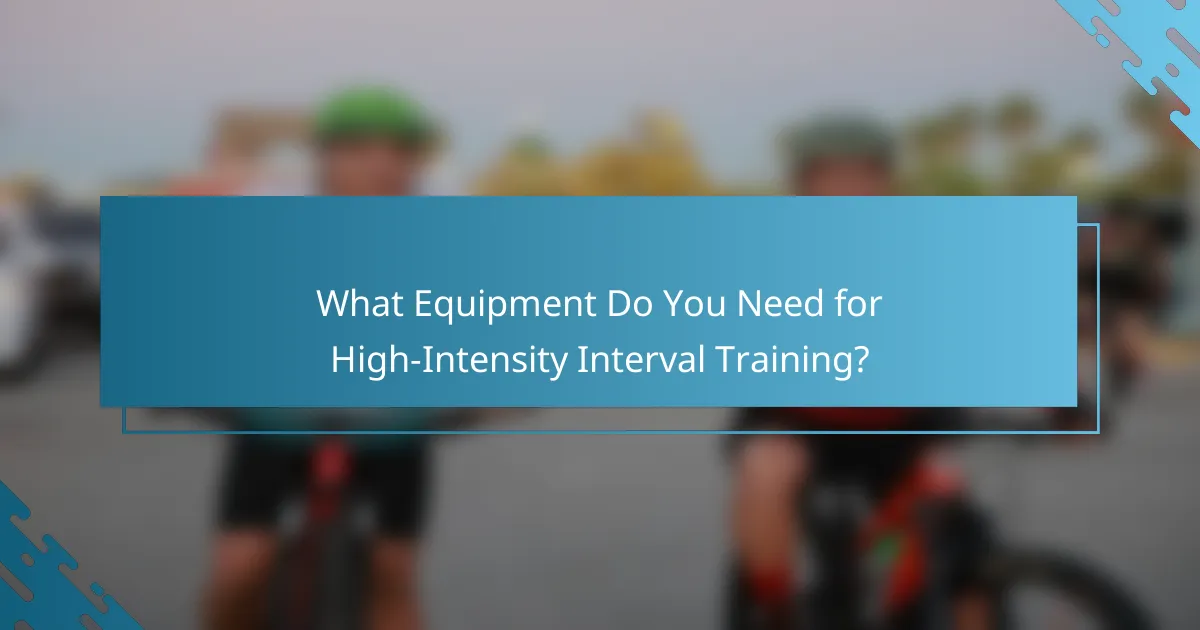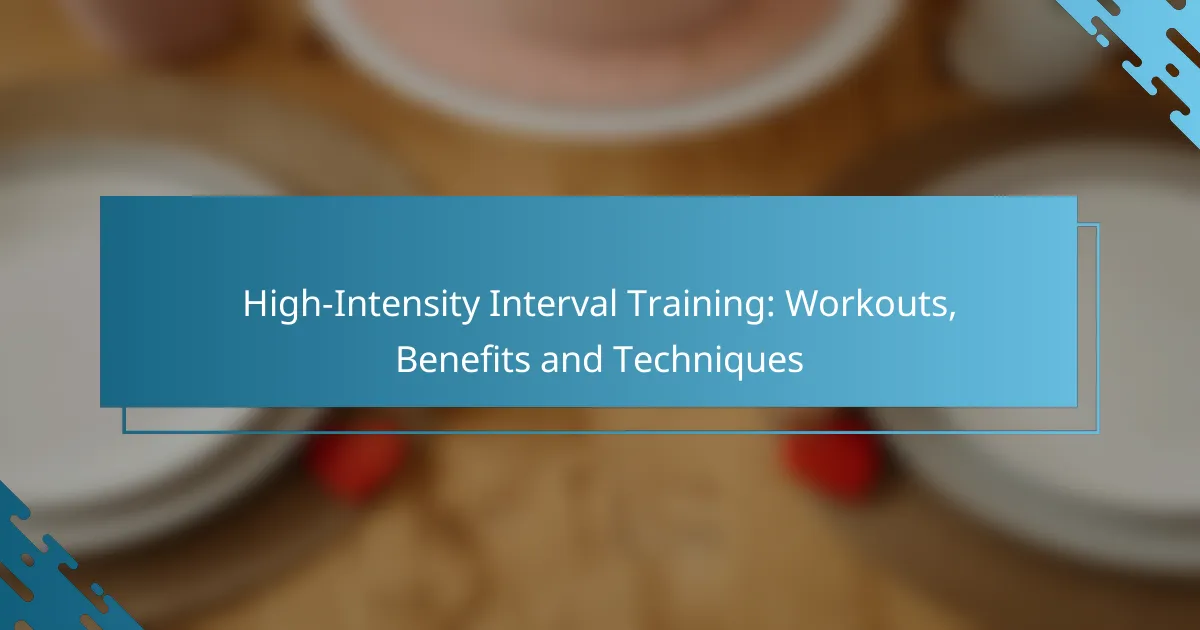High-Intensity Interval Training (HIIT) is a time-efficient workout method that alternates between intense exercise bursts and recovery periods, maximizing calorie burn and enhancing cardiovascular fitness. This approach not only improves heart health and boosts metabolic rates but also helps in achieving better muscle tone. By assessing your fitness level and setting clear goals, you can effectively incorporate HIIT into your routine for optimal results.

What Are the Best High-Intensity Interval Training Workouts?
The best high-intensity interval training (HIIT) workouts maximize calorie burn and improve cardiovascular fitness in a short amount of time. These workouts typically alternate between short bursts of intense exercise and recovery periods, making them efficient and effective for various fitness levels.
Tabata Training
Tabata training is a specific form of HIIT that consists of 20 seconds of ultra-intense exercise followed by 10 seconds of rest, repeated for a total of eight rounds, lasting four minutes. This method is effective for improving both aerobic and anaerobic fitness. Common exercises include burpees, squats, and push-ups.
To implement Tabata, choose an exercise, set a timer, and push yourself to the limit during the 20-second intervals. Ensure proper form to avoid injury, and consider starting with one or two rounds if you’re new to this format.
Fartlek Training
Fartlek training combines continuous running with interval training, allowing for varied intensity levels throughout a workout. This method is often used by runners to improve speed and endurance by alternating between fast and slow paces. It can be done on a track, trail, or road.
To practice Fartlek, choose a distance and incorporate bursts of speed followed by slower recovery periods. For example, sprint for 30 seconds, then jog for 1-2 minutes, repeating this cycle for the duration of your run. This approach keeps workouts engaging and adaptable to your fitness level.
HIIT Circuit Training
HIIT circuit training involves performing a series of exercises in sequence with minimal rest between them, targeting different muscle groups. This format can include bodyweight exercises, resistance training, or cardio moves, making it versatile and effective for building strength and endurance.
To create a circuit, select 4-6 exercises, such as jumping jacks, lunges, push-ups, and mountain climbers. Perform each for 30 seconds, followed by 15 seconds of rest, and repeat the circuit 2-3 times. Adjust the intensity and duration based on your fitness level.
Bodyweight HIIT Exercises
Bodyweight HIIT exercises utilize your own weight for resistance, making them accessible and convenient. These workouts can be done anywhere and require no equipment, focusing on movements like squats, planks, and burpees.
To design a bodyweight HIIT session, choose 5-7 exercises and perform each for 30 seconds with 15 seconds of rest in between. Aim for 3-4 rounds, ensuring you maintain proper form to maximize effectiveness and reduce injury risk.
HIIT with Weights
HIIT with weights incorporates resistance training into high-intensity intervals, enhancing muscle strength while boosting cardiovascular fitness. This approach can involve dumbbells, kettlebells, or resistance bands, allowing for a comprehensive workout.
For a weights-based HIIT workout, select 4-5 exercises such as deadlifts, shoulder presses, and goblet squats. Perform each for 30 seconds, followed by 15 seconds of rest, and complete 3-4 rounds. Start with lighter weights to master the movements before progressing to heavier loads.

What Are the Benefits of High-Intensity Interval Training?
High-Intensity Interval Training (HIIT) offers numerous benefits, including improved cardiovascular health, increased metabolic rate, time efficiency, and enhanced muscle tone. These advantages make HIIT a popular choice for individuals seeking effective workouts in shorter durations.
Improved Cardiovascular Health
HIIT significantly boosts cardiovascular health by increasing heart rate and improving circulation. Engaging in short bursts of intense activity followed by rest periods can enhance heart function and reduce the risk of heart disease.
To maximize cardiovascular benefits, aim for sessions that elevate your heart rate to 80-90% of its maximum for short intervals, followed by lower-intensity recovery periods. This approach can lead to improved endurance and overall heart health.
Increased Metabolic Rate
One of the key benefits of HIIT is its ability to elevate your metabolic rate, even after the workout has ended. This phenomenon, known as excess post-exercise oxygen consumption (EPOC), allows your body to burn more calories throughout the day.
Incorporating HIIT into your routine can increase your resting metabolic rate by a notable percentage. For effective results, consider performing HIIT workouts 2-3 times a week, allowing for adequate recovery between sessions.
Time Efficiency
HIIT is particularly time-efficient, allowing you to achieve significant fitness gains in shorter workout durations. Many HIIT sessions can be completed in 20-30 minutes, making it an ideal option for those with busy schedules.
To optimize your time, focus on high-intensity intervals lasting 20-40 seconds, followed by equal or slightly longer rest periods. This structure keeps workouts concise while still delivering powerful results.
Enhanced Muscle Tone
HIIT workouts can lead to improved muscle tone by incorporating strength training elements alongside cardiovascular exercises. This combination helps build lean muscle mass while simultaneously burning fat.
To enhance muscle tone, include bodyweight exercises like squats, push-ups, and burpees in your HIIT routine. Aim for a balanced approach that targets multiple muscle groups, ensuring a comprehensive workout that promotes overall strength and definition.

How to Start a High-Intensity Interval Training Program?
Starting a high-intensity interval training (HIIT) program involves assessing your current fitness level, setting clear goals, selecting suitable workouts, and establishing a consistent schedule. This structured approach ensures you maximize benefits while minimizing the risk of injury.
Assess Your Fitness Level
Before beginning a HIIT program, evaluate your current fitness level to tailor the intensity and duration of your workouts. Consider factors such as your cardiovascular endurance, strength, and any previous exercise experience.
A simple way to assess your fitness is through a basic fitness test, such as a timed run or a maximum number of push-ups. This baseline will help you track progress and make necessary adjustments as you advance.
Set Clear Goals
Establishing clear, achievable goals is crucial for maintaining motivation in your HIIT program. Whether your aim is to lose weight, build muscle, or improve endurance, having specific targets will guide your training.
Consider using the SMART criteria—specific, measurable, achievable, relevant, and time-bound—to define your goals. For example, aim to complete a certain number of HIIT sessions per week or improve your sprint time over a set period.
Choose Appropriate Workouts
Select workouts that match your fitness level and goals. HIIT can include various exercises such as sprinting, cycling, bodyweight movements, or resistance training. Choose a mix that keeps you engaged and challenges your body.
For beginners, starting with shorter intervals (20-30 seconds of high intensity followed by equal or longer rest periods) is advisable. As you progress, you can increase the intensity and duration of the work intervals.
Establish a Schedule
Creating a consistent workout schedule is essential for success in a HIIT program. Aim for at least two to three sessions per week, allowing adequate recovery time between workouts to prevent burnout and injury.
Consider scheduling your HIIT sessions at times that fit your lifestyle, whether in the morning, during lunch, or after work. Consistency will help you build a habit and see results over time.

What Equipment Do You Need for High-Intensity Interval Training?
High-Intensity Interval Training (HIIT) can be performed with minimal equipment, but certain tools can enhance your workouts. Essential equipment includes resistance bands, dumbbells, jump ropes, and medicine balls, each serving unique purposes to boost intensity and effectiveness.
Resistance Bands
Resistance bands are versatile tools that add extra resistance to your HIIT workouts. They come in various strengths, allowing you to adjust the intensity based on your fitness level. You can use them for exercises like squats, lunges, and upper body movements.
When using resistance bands, ensure they are securely anchored to avoid injury. Look for bands that are color-coded to indicate resistance levels, typically ranging from light to heavy. This allows for progressive overload as you get stronger.
Dumbbells
Dumbbells are excellent for adding weight to your HIIT routines, helping to build strength and muscle endurance. They are available in various weights, typically ranging from 1 kg to 20 kg or more, making them suitable for all fitness levels.
Incorporate dumbbells into exercises like thrusters, kettlebell swings, or shoulder presses. Start with lighter weights to master your form, then gradually increase the weight as your strength improves. Always maintain proper technique to prevent injuries.
Jump Ropes
Jump ropes are a fantastic way to elevate your heart rate quickly during HIIT sessions. They are lightweight, portable, and can be used almost anywhere, making them an ideal choice for quick workouts.
To effectively use a jump rope, aim for intervals of 30 seconds to 1 minute of jumping, followed by short rest periods. This can significantly improve cardiovascular fitness and coordination. Choose a rope that suits your height for optimal performance.
Medicine Balls
Medicine balls are great for adding explosive movements to your HIIT training. They come in various weights, generally ranging from 1 kg to 10 kg, and can be used for a variety of exercises, including slams, twists, and throws.
When selecting a medicine ball, consider your current strength level and the types of exercises you plan to perform. Use them to enhance core strength and power, but ensure you have enough space to perform movements safely without risk of injury.

What Are Common Mistakes in High-Intensity Interval Training?
Common mistakes in high-intensity interval training (HIIT) can hinder performance and increase the risk of injury. Understanding these pitfalls is essential for maximizing the benefits of HIIT workouts while ensuring safety and effectiveness.
Skipping Warm-Ups
Many individuals overlook the importance of warming up before engaging in high-intensity workouts. Skipping warm-ups can lead to muscle strains and decreased performance due to insufficient blood flow and flexibility.
A proper warm-up should last about 5 to 10 minutes and include dynamic stretches and light aerobic exercises. This prepares the body for the intensity of HIIT, enhancing overall effectiveness and reducing injury risks.
Overtraining
Overtraining is a common mistake in HIIT that can lead to fatigue, decreased performance, and even injury. It occurs when the body is subjected to excessive training without adequate recovery time.
To avoid overtraining, incorporate rest days into your routine and listen to your body. Signs of overtraining include persistent fatigue, irritability, and a decline in workout performance. Aim for a balanced approach, allowing at least one to two rest days per week to recover fully.
